How to monitor buyer personas in your HubSpot portal
How to monitor buyer personas in your HubSpot portal
Get weekly
HubSpot Updates
Nobody stays the same, and that includes your buyer personas. They’re based on real people, so you can’t assume they’re ever finished: they’re an ongoing project. They’re fluid, evolving entities that need to be constantly monitored, revised and updated.
If you don’t tweak your buyer personas, adding and subtracting new information you find out about your customers, then you’re going to be targeting the wrong people with the wrong material – this means you’d might as well not have personas at all.
Think about yourself five years ago: where were you and what were you doing? How have you changed in the five years since?
I’ll give you an example: five years ago, I was a 26-year-old secondary school English teacher, preparing to leave my job and travel the world for a year, attending gruelling gym sessions five evenings a week.
Let’s compare that to my current life: I am now a 31-year-old Senior Content Strategist for SpotDev, have just bought my first home and haven’t been to the gym in 6 weeks (though my membership fee dutifully leaves my bank account every 1st of the month – that counts for something, right?)
If I was your ideal buyer persona five years ago, would I still be now?
Would you have updated my profile with these preference/goal changes?
Could you still sell your product to me?
If you’re using the HubSpot persona tool, monitoring your personas couldn’t be easier to do – and here we show you how to get the most out of it.
![]()
Assigning your customers to personas
Once you’ve started creating your personas (don’t over-do it to start with; build them up gradually), you can start assigning each of your contacts to a persona. You can do this manually, assigning a persona one by one through the contacts tool, or you can use the HubSpot workflows or imports tools to populate multiple contacts at a time, using a spreadsheet first. However you assign your contacts, this activity allows you to segment your audience, and with that comes all sorts of marvellous advantages:
You can start:
- Creating content that goes out to specific groups: Lead magnets, marketing campaigns, email promotions – you name it, you can now target this specific group and ensure they are the only ones receiving a particular piece of content.
- Excluding customers from content you know won’t be relevant to them: At the moment, certain contacts may see some of the collateral they receive from you as spammy. You can cater content to a contact’s pain points, goals, stage in the buyer’s journey, geographical region, budget or job role – the ways to segment go on and on!
- Tailoring the user journey on your site: For example, you might have different landing page variants for the same lead magnet, depending on which persona has landed there: your twenty-something traveller planning a backpacking trip on a shoestring might see a hostel image, while your luxury holidaymaker in their fifties sees images of a plush resort: but the downloadable offer is the same.
- Editing forms to include more specific fields: You might already know certain details about one persona from an earlier stage, but now you want to probe into another area, such as the size of their team or their location – this can be personalised according to persona.
- Looking for patterns: Which groups are responding most to your social media activity? Who spends longest on your blog? Which persona is most likely to fill in a form in return for a lead magnet? These questions are key to helping you forge highly targeted, personalised experiences for your customers and prospects.
As SocialBakers explored in their recent article:
“Tailoring your content to fit your audience’s needs is a sure way to generate results. When comparing personalised content to un-personalised content, 80% of marketers find that it’s more effective. However, due to lack of technology and resources, content creators are not fully taking advantage of the power of personalisation in the digital age.”
This level of personalisation – that so many marketers are missing – is what will separate you from competitors and, ultimately, lead to a much more pleasant user experience for your visitors. When you assign each of your contacts to a persona in HubSpot, you’re treating them as individuals, not a crowd.
Monitoring their activity
Once you’ve assigned each contact to a persona in HubSpot – and created a way for this to become a repeatable, standard procedure in your business – you can start monitoring the activity of each persona. Which campaigns are successes and which need some refining?
In your portal, HubSpot works out what percentage of your contacts fit into each persona, therefore highlighting which your biggest groups are, down to your smallest groups: this will help you prioritise your marketing efforts and decide which campaigns to run for each persona. For example, you might choose to focus most of your marketing efforts on your largest persona, then create some quick-win strategies to cater for your smaller personas.
In your HubSpot portal, you can break down your personas even further into:
- MQLs
- Leads
- Customers
- All contacts.
This granular data is golden and can tell you so much about how your personas are engaging with your content, behaving online and becoming customers. For example, your portal might show you that Bridal Betty leads (your persona for soon-to-be married women) are engaging with your different channels like this:

By monitoring your Bridal Betty persona, you can learn different things through the charts provided by HubSpot:

- Your email marketing is working effectively: average email open rates are around 24% and yours are 23% – you’re happy with this.
- Your target might have been for 10% conversion on forms, so you’re thrilled with the higher 15% result.
- Your keyword research is really strong because over half of your ‘Bridal Bettys’ are finding you through organic search.
- You’ve been working really hard on your social activity during this campaign though, so 0% clicks on your social link is a disappointing ROI.
You’re now armed, in a really simple, quick and easy way, with loads of data to draw conclusions from and start looking for patterns. For example, if your social campaign last month had a 21% click-through rate and this month it was 0%, you’d start to analyse what it was you did differently between the two months. In future, you’d decide to repeat last month’s strategy, rather than whatever went wrong this month.
Stephanie Tran from SparkReaction advises to also look out for factors such as the speed it takes for users to convert (which can also be done in HubSpot by creating a report then filtering by persona type, as well as in Databox):
“If they're the right buyer personas, they'll have a quick, easy, and hyper-focused path to take. On the reverse side, improper personas will have a difficult time bumbling down your purchase path. Conversions won't come as easily to them, and there may be a bigger education curve that lengthens conversion time.”
If a particular persona is regularly bouncing around landing pages without filling in forms or isn’t moving along your flywheel in other ways, you might want to ask yourself questions, such as:
- Is your conversion time too lengthy for new leads?
- Is new traffic failing to convert on your offers?
- Are you losing traffic that bounces off your page?
- Are you trying to do too much with your persona: could it really be split into two separate ones?
- Have you spent enough time talking to your personas about their habits?
- Are your keywords for this persona accurate and have you optimised your content with them?
Using your analysis to tweak your content (or personas)
After a while of gathering data (HubSpot allows you to flip between different months to compare and contrast engagement across different time periods) you might realise that some things you’re doing are consistently not working for your persona.
If your Bridal Betty persona is consistently ignoring social links, month after month, and preferring to open your links through email – and you’ve got it written in your persona that this contact is typically social-media obsessed – then you’ve got a problem.
It’s not enough to only use this insight to tweak your content in future; you’re going to have to revisit your persona and update their story. Something you thought you knew about your persona was either incorrect from the start, or has changed – and that’s okay (as long as you react to it!).
Top tip: Talking to a few real customers about why they aren’t engaging with your social activity will give you more qualitative insights, and assure that what the data shows is also correct from a human perspective – there might be a good reason for this persona’s indifference on your social channels.
Once you’re sure of your findings, you can easily update the persona description in your HubSpot portal and voilà – it’s more accurate for everyone across your business to use.
Personas aren’t a finished project and, we know, for some people that can be frustrating – but regularly revisiting them, checking how each is getting along in your portal and updating them as needed will put you in the 44% of marketers using personas – and in the 15% of them, actually doing it well.
Our content includes affiliate links. This means that we may receive a commission if you make a purchase through one of the links on our website. This will be at no cost to you and helps to fund the content creation work on our website.